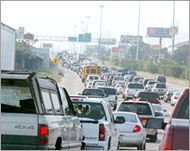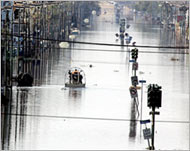Coastal Texas evacuates ahead of Rita
More than a million people have been ordered to evacuate Texas and Louisiana as Rita, now a Category 5, 281kph hurricane, swirls towards the US Gulf Coast with growing strength and speed.

Having learned a bitter lesson from Hurricane Katrina three weeks ago, authorities in Texas and Louisiana have ordered the mandatory evacuation of some 1.3 million people in Rita’s path.
Forecasters said Rita could be the most intense hurricane on record ever to hit Texas, and easily one of the most powerful ever to plough into the US mainland.
Category 5 is the highest on the scale, and only three Category 5 hurricanes are known to have hit the US mainland – most recently, Andrew, which smashed South Florida in 1992.
“It’s scary. It’s really scary,” Shalonda Dunn said as she and her five and nine-year-old daughters waited to board a bus arranged by emergency authorities in Galveston.
“I’m glad we’ve got the opportunity to leave … . You never know what can happen.”
Evacuation urged
With Rita projected to hit Texas by Saturday, Governor Rick Perry urged residents along the state’s entire coast to begin evacuating. And New Orleans braced for the possibility that the storm could swamp the misery-stricken city all over again.
Galveston, low-lying parts of Corpus Christi, and Houston, as well as mostly emptied-out New Orleans were under mandatory evacuation orders as Rita sideswiped the Florida Keys and began drawing energy with terrifying efficiency from the warm waters of the Gulf of Mexico.
 |
|
A mass evacuation of the |
The US mainland has never been hit by both a Category 4 and a Category 5 in the same season.
Katrina, at one point became a Category 5 storm, but weakened slightly to a Category 4 hurricane just before coming ashore.
Government officials eager to show they had learned their lessons from the sluggish response to Katrina sent in hundreds of buses to evacuate the poor, moved out hospital and nursing home patients, dispatched truckloads of water, ice and ready-made meals, and put rescue and medical teams on standby.
An army general in Texas was told to be ready to assume control of a military task force in Rita’s wake.
“We hope and pray that Hurricane Rita will not be a devastating storm, but we got to be ready for the worst,” President George W Bush said in Washington.
Breathtaking size
Late on Wednesday, Rita was centred about 917km east-southeast of Galveston and was moving west near 14.5 kph.
Forecasters predicted it would come ashore along the central Texas coast between Galveston and Corpus Christi. Hurricane-force winds extended up to 113km from the centre of the storm.
 |
|
Hurricane-force winds extended |
But with its breathtaking size – tropical storm-force winds extending 595km across – practically the entire western end of the US Gulf Coast was in peril, and even a slight rightward turn could prove devastating to the fractured levees protecting New Orleans.
In the Galveston-Houston-Corpus Christi area, about 1.3 million people were under orders to get out, in addition to 20,000 or more along with the Louisiana coast.
Special attention was given to hospitals and nursing homes, three weeks after scores of sick and elderly patients in the New Orleans area drowned in Katrina’s floodwaters or died in the stifling heat while waiting to be rescued.
Logistical problems
Galveston, a city of 58,000 on a coastal island 2.4 metres above sea level, was the site of one of the deadliest natural disasters in US history: an unnamed hurricane in 1900 that killed between 6000 and 12,000 people and practically wiped the city off the map.
 |
|
Hospitals and retirement homes |
The last major hurricane to strike the Houston area was Category-3 Alicia in 1983. It flooded downtown Houston, spawned 22 tornadoes and left 21 people dead.
In Houston, the state’s largest city and home to the highest concentration of Katrina refugees, the area’s geography makes evacuation particularly tricky.
While many hurricane-prone cities are right on the coast, Houston is 100km inland, so a coastal suburban area of 2 million people must evacuate through a metropolitan area of four million people where the freeways are often clogged under the best of circumstances.
Bus shortage
Mayor Bill White urged residents to look out for more than themselves.
|
“There will not be enough government vehicles to go and evacuate everybody in every area. We need neighbour caring for neighbour” Bill White |
“There will not be enough government vehicles to go and evacuate everybody in every area,” he said. “We need neighbour caring for neighbour.”
Houston Police Chief Harold Hurtt issued a stern warning to anyone staying behind that looting would not be tolerated and anyone caught stealing after the storm would be prosecuted.
Mayor Lyda Ann Thomas warned late on Wednesday that the city was nearly out of buses. She said those left on the island will have to find a way off or face riding out a storm that is “big enough to destroy part of the island, if not a great part of the county”.
City Manager Steve LeBlanc said the storm surge could reach 15 metres.
Galveston is protected by a seawall that is only five metres tall.
Katrina victims
More than 180 police officers were expected to stay behind to guard the city, along with 117 firefighters.
 |
|
The death toll in the Hurricane |
Rita approached as the death toll from Katrina passed the 1000 mark – to 1036 – in five Gulf Coast states. The body count in Louisiana alone was put at 799, most found in the receding floodwaters of New Orleans.
Rita also forced some Katrina victims to flee a hurricane for the second time in three and a half weeks. More than 1000 refugees who had been living in the civic centre in Lake Charles, near the Texas state line, were being transported to shelters further north.
Crude oil prices rose again on fears that Rita would smash into key oil installations in Texas and the gulf. Hundreds of workers were evacuated from offshore oil rigs. Texas, the heart of US crude production, accounts for 25% of the nation’s total oil output.
Rita is the 17th named storm of the Atlantic hurricane season, making this the fourth-busiest season since record-keeping started in 1851. The record is 21 tropical storms in 1933. The hurricane season is not over until 30 November.
US National Hurricane Centre: http://www.nhc.noaa.gov